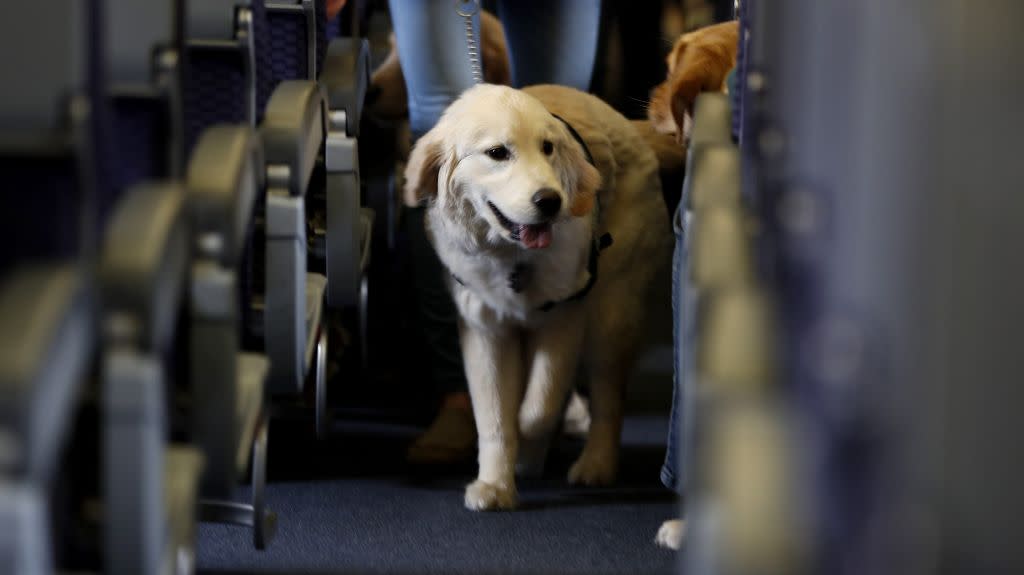Flying with an emotional support animal may soon get a whole lot more difficult

Emotional support animals come in all shapes and sizes—as large and ostentatious as a miniature horse or full-sized peacock, or as unobtrusive as a well-trained guinea pig. Some offer support via timely yaps, others by quiet companionship. Some are friends to all, others take their work too seriously to bother with strangers.
In the US, most public places are under no obligation to make any allowance for these animals, whatever their demeanor or size. The Americans with Disabilities Act (ADA) defines service animals in terms of their extensive training—think guide dogs or medical-emergency animals that receive months of specialized instruction. But emotional support animals, who may receive no training whatsoever, are excluded from the law’s protection.
The Air Carrier Access Act (ACAA), enforced by the US Department of Transportation, takes a much looser approach. It decrees that almost any animal that provides assistance to a person with a disability, including “emotional support,” should be permitted in a US aircraft cabin. (Snakes, spiders, and the fist-sized possums known as sugar gliders are on a special no-fly list.) Emotional support animals may sit in aisles, under seats, or on laps. And airlines don’t like that one bit.
A crackdown is underway
As of last year, airlines can now require paperwork in advance that confirms animals have been vaccinated, are certified as emotional support animals, and that their owners take complete responsibility for them. Since August, airline employees have been able to exclude animals they consider to be a safety risk—though excluding entire dog or cat breeds is prohibited.
More rules may be forthcoming. In a months-long open session last year, the department received around 4,500 comments on the topic. In response, it announced in August this year that a Notice of Proposed Rulemaking on the transportation of service animals would come as soon as it had reviewed these comments. Many came from a coalition of stakeholders—multiple US carriers, flight attendant and pilot unions, guide-dog foundations, and members of the disability community—who have asked federal officials to up the ante and put further restrictions in place.
“We are all petitioning the DoT to change that law and have it match the ADA, which would mean emotional support animals are not allowed on planes,” says American Airlines’ Gina Emrich, who runs the company’s efforts in accessibility.
It’s partly a question of scale, she says. While airlines might have 5,000 trained service animals flying a month, they may need to accommodate as many as 20,000 untrained support animals. “The volume is just significant,” says Emrich. “It’s exponential at Christmas time, because nobody wants to go see their family without them.”
The danger to human and animal
A lack of scruples about what is and is not an emotional support animal is putting pressure on people with legitimate disabilities, who may be subject to undue suspicion for their own service animals, Emrich says: “People who truly need service dogs—we keep trying to tell the Department of Transportation that this hurts them.”
Untrained animals have attacked trained service dogs, occasionally resulting in the service dog being retired. “A trained service dog is sometimes a larger dog, because they’re providing guidance,” says Emrich. “So you can’t pick them up and protect them from an animal who might be trying to attack them.” For the owner, it can be hugely disruptive. If the dog can no longer work, they sometimes face a temporary loss of independence until a replacement can be found. Untrained animals are a liability for airlines in other respects. “We have flight attendants bit all the time,” she says. “We’ve had other customers bit too, not to mention allergies and other issues.”
It’s no fun being the bad guy, of course. “People tell us that all the time: ‘I don’t understand why you should care. Why do you care if it’s fraud that I bring this animal and I don’t really need it for emotional support? What difference does that make?'” Emrich explains. “But then, when you explain to them the impact on the people around them, or on the people who have true trained service animals, they’re like, ‘Oh.’ And they rethink it.”
Sign up for the Quartz Daily Brief, our free daily newsletter with the world’s most important and interesting news.
More stories from Quartz:

